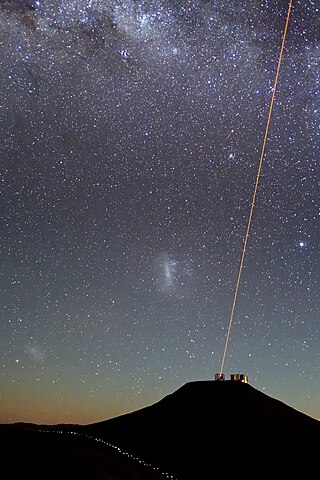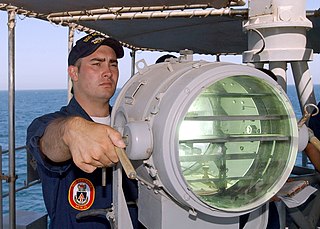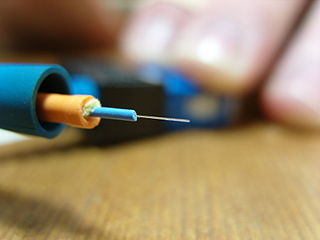Related Research Articles

An optical amplifier is a device that amplifies an optical signal directly, without the need to first convert it to an electrical signal. An optical amplifier may be thought of as a laser without an optical cavity, or one in which feedback from the cavity is suppressed. Optical amplifiers are important in optical communication and laser physics. They are used as optical repeaters in the long distance fiberoptic cables which carry much of the world's telecommunication links.

In fiber-optic communications, wavelength-division multiplexing (WDM) is a technology which multiplexes a number of optical carrier signals onto a single optical fiber by using different wavelengths of laser light. This technique enables bidirectional communications over a single strand of fiber, also called wavelength-division duplexing, as well as multiplication of capacity.

Optical communication, also known as optical telecommunication, is communication at a distance using light to carry information. It can be performed visually or by using electronic devices. The earliest basic forms of optical communication date back several millennia, while the earliest electrical device created to do so was the photophone, invented in 1880.
All-silica fiber, or silica-silica fiber, is an optical fiber whose core and cladding are made of silica glass. The refractive index of the core glass is higher than that of the cladding. These fibers are typically step-index fibers. The cladding of an all-silica fiber should not be confused with the polymer overcoat of the fiber.
Hybrid fiber-coaxial (HFC) is a telecommunications industry term for a broadband network that combines optical fiber and coaxial cable. It has been commonly employed globally by cable television operators since the early 1990s.

A passive optical network (PON) is a fiber-optic telecommunications technology for delivering broadband network access to end-customers. Its architecture implements a point-to-multipoint topology in which a single optical fiber serves multiple endpoints by using unpowered (passive) fiber optic splitters to divide the fiber bandwidth among the endpoints. Passive optical networks are often referred to as the last mile between an Internet service provider (ISP) and its customers. Many fiber ISPs prefer this technology.

Multi-mode optical fiber is a type of optical fiber mostly used for communication over short distances, such as within a building or on a campus. Multi-mode links can be used for data rates up to 100 Gbit/s. Multi-mode fiber has a fairly large core diameter that enables multiple light modes to be propagated and limits the maximum length of a transmission link because of modal dispersion. The standard G.651.1 defines the most widely used forms of multi-mode optical fiber.

An optical fiber, or optical fibre in Commonwealth English, is a flexible, transparent fiber made by drawing glass (silica) or plastic to a diameter slightly thicker than that of a human hair. Optical fibers are used most often as a means to transmit light between the two ends of the fiber and find wide usage in fiber-optic communications, where they permit transmission over longer distances and at higher bandwidths than electrical cables. Fibers are used instead of metal wires because signals travel along them with less loss; in addition, fibers are immune to electromagnetic interference, a problem from which metal wires suffer. Fibers are also used for illumination and imaging, and are often wrapped in bundles so they may be used to carry light into, or images out of confined spaces, as in the case of a fiberscope. Specially designed fibers are also used for a variety of other applications, some of them being fiber optic sensors and fiber lasers.
Ciena Corporation is an American telecommunications networking equipment and software services supplier based in Hanover, Maryland. The company has been described by The Baltimore Sun as the "world's biggest player in optical connectivity." The company reported revenues of $3.63 billion for 2022. Ciena had over 8,000 employees, as of October 2022. Gary Smith serves as president and chief executive officer (CEO).
Optical networking is a means of communication that uses signals encoded in light to transmit information in various types of telecommunications networks. These include limited range local-area networks (LAN) or wide-area networks (WAN), which cross metropolitan and regional areas as well as long-distance national, international and transoceanic networks. It is a form of optical communication that relies on optical amplifiers, lasers or LEDs and wave division multiplexing (WDM) to transmit large quantities of data, generally across fiber-optic cables. Because it is capable of achieving extremely high bandwidth, it is an enabling technology for the Internet and telecommunication networks that transmit the vast majority of all human and machine-to-machine information.
American Photonics, Inc. (API) was a very early developer of local area network technologies in the 1980s, based first in Brewster, New York, moving later to Brookfield Center, Connecticut.

Fiber-optic communication is a method of transmitting information from one place to another by sending pulses of infrared light through an optical fiber. The light is a form of carrier wave that is modulated to carry information. Fiber is preferred over electrical cabling when high bandwidth, long distance, or immunity to electromagnetic interference is required. This type of communication can transmit voice, video, and telemetry through local area networks or across long distances.
Kevin Kimberlin is chairman of Spencer Trask & Co., a technology firm. Kimberlin's career includes work with Jonas Salk, Walter Gilbert, John Wennberg and Robert Langer.
Wavelength selective switching components are used in WDM optical communications networks to route (switch) signals between optical fibres on a per-wavelength basis.

A fiber media converter is a simple networking device that makes it possible to connect two dissimilar media types such as twisted pair with fiber optic cabling. They were introduced to the industry in the 1990s, and are important in interconnecting fiber optic cabling-based systems with existing copper-based, structured cabling systems. They are also used in metropolitan area network (MAN) access and data transport services to enterprise customers.
Rod C. Alferness was president of The Optical Society in 2008.
Santur Corporation developed, manufactured and commercialized tunable lasers as well as parallel array devices and photonic integrated circuits for the telecommunications industry. It was established in November 2000 in Fremont, California initially developing and commercializing the tunable lasers for metro and long-haul dense wavelength-division multiplexing (WDM) systems. The company had a patented a Distributed Feedback Laser (DFB)-array technology, which enabled the manufacture of broadly tunable sources that have the same performance and reliability as fixed DFBs. Santur claimed to have set a new standard in the telecommunications industry with its technology that features a unique combination of high power, wide tunability, stability, Telcordia GR-468 reliability, and value.
Spencer Trask & Co. is a privately held advanced technology development company.
A super-channel is an evolution in dense wavelength-division multiplexing (DWDM) in which multiple, coherent optical carriers are combined to create a unified channel of a higher data rate, and which is brought into service in a single operational cycle.
Optelecom-NKF, Inc. is an American company that designs, manufactures, and markets high-bandwidth communications products, financial market data information, and business video systems.
References
- ↑ Huber, D.R.; Glaab, J.B. (October–December 1990). "Optical amplifiers for video distribution". International Journal of Digital & Analog Communication Systems. 3 (4): 333–339. doi:10.1002/dac.4510030408.
- ↑ "Business Brief". The Washington Post. May 17, 1993.
- ↑ Hecht, Jeff (October 2016). "Boom, Bubble, Bust: The Fiber Optic Mania". Optics and Photonics News: 47.
- 1 2 Auerweck, Steve (May 17, 1993). "Optelecom, HydraLite become partners Optelecom Inc. of Gaithers...". The Baltimore Sun.
- ↑ Markoff, John (March 3, 1997). "Fiber-Optic Technology Draws Record Stock Value". The New York Times.
- ↑ Hirsch, Stacey (February 2, 2006). "Huber steps down as CEO of Broadwing". The Baltimore Sun.
- ↑ "Level 3 to buy Broadwing for $1.4B". Baltimore Business Journal. October 17, 2006.